Adding a Non-Descriptor-Based REST API Test
First, let us take the example of an environment monitored by eG Enterprise. This example involves creating a AlarmRESTAPI_ex test, that will provide the count of alarms generated by eG Enterprise based on the severity.
Begin adding a new test by selecting the Test option from the Integration Console tile (see Figure 1). In the integration console - test page that appears next, click the Add New Test button. The new test details page (see Figure 1) appears, wherein the following details need to be provided for our example:
-
Test type - Performance
-
Test name – AlarmRESTAPI_ex
Note:
While adding a new test using the Integration Console, ensure that the Test name always ends with _ex. If not, an error message (see Figure 3) will appear upon clicking the Add button in Figure 1.
- Duplicate - Since the new test is not a duplicate of any existing test, set the Duplicate flag to No.
-
Execution – Internal, as an internal agent will be executing the test.
Note:
Using the Integration Console plugin, you can add an internal or an external test, but you cannot add tests that need to be run by a remote agent – i.e., tests that need to be executed in an agentless manner.
- Port based – Indicate whether the target server is listening on a port or not.
- Category - REST
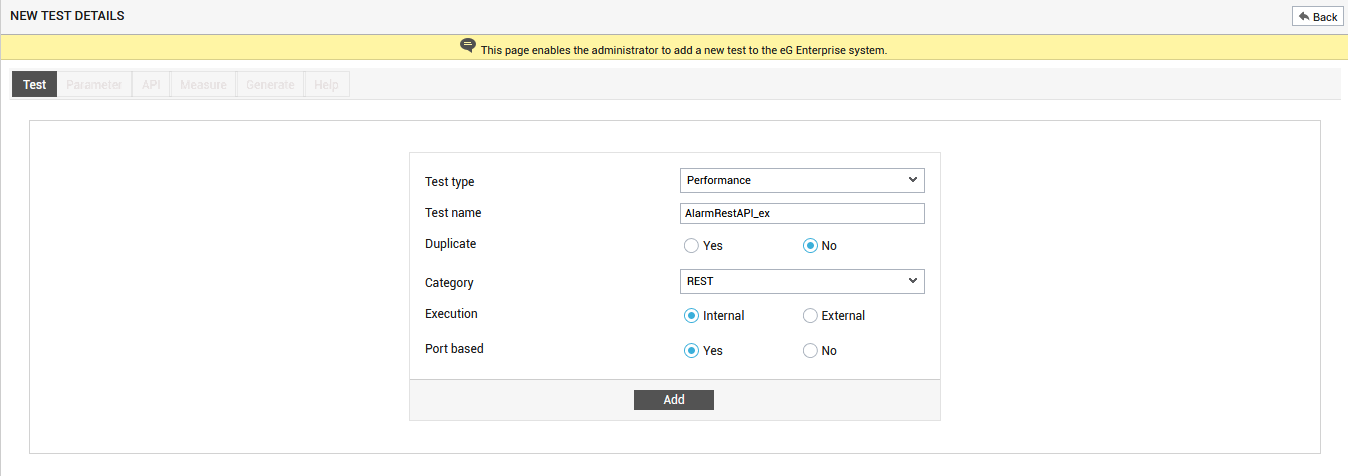
Figure 1 : Adding a new test of type REST
Then, click the Add button to add the new test to eG Enterprise. The API tab page then opens automatically (see Figure 2).
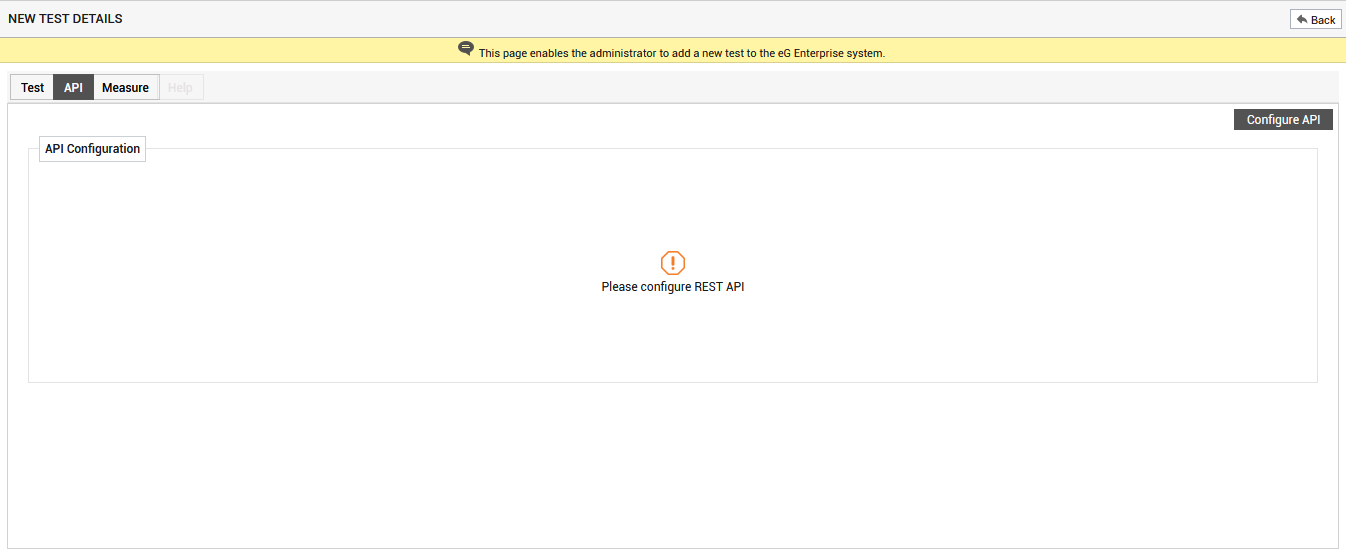
Click the Configure API button in Figure 2 to configure a REST API of your choice. Figure 3 then appears.
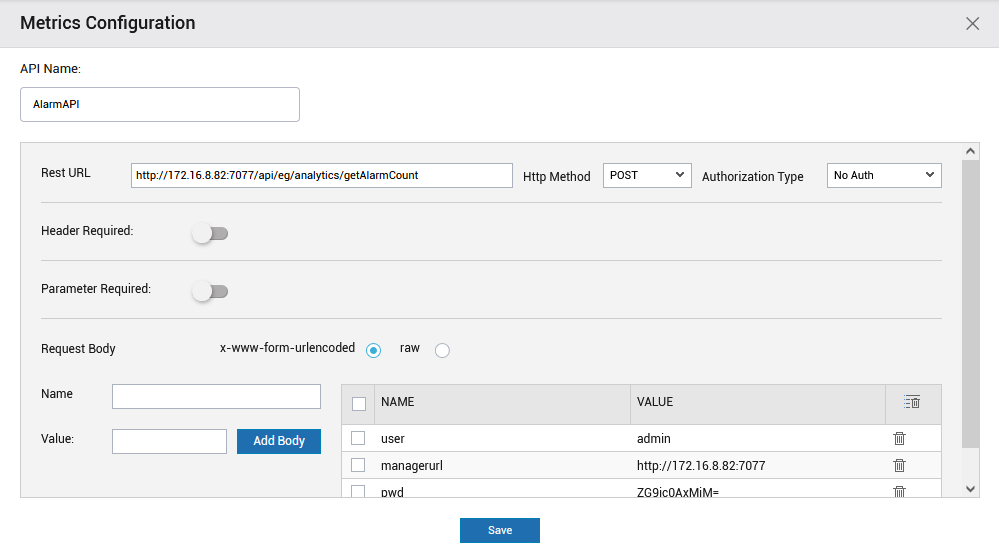
Figure 3 : Configuring the REST API
In Figure 3, specify the following:
-
API Name - Specify the name of the API that you wish to configure.
-
REST URL - Specify the exact REST URL that this test should connect to and collect the required metrics.
-
HTTP Method - Here, pick the required HTTP Method. By default, this is set to GET.
-
Authorization Type - Here, pick the authorization type that is used for accessing the target environment using REST URL.
-
No Auth - By default, No Auth will be chosen from this list (see Figure 3). This indicates that the data can be collected by any user from the REST URL.
-
Basic Auth - In some environments, only a specific user will be authorized to execute the REST API in order to collect the required data. In such environments, administrators can specify the credentials of the user who is authorized to execute the REST API in the User name and Password text boxes.
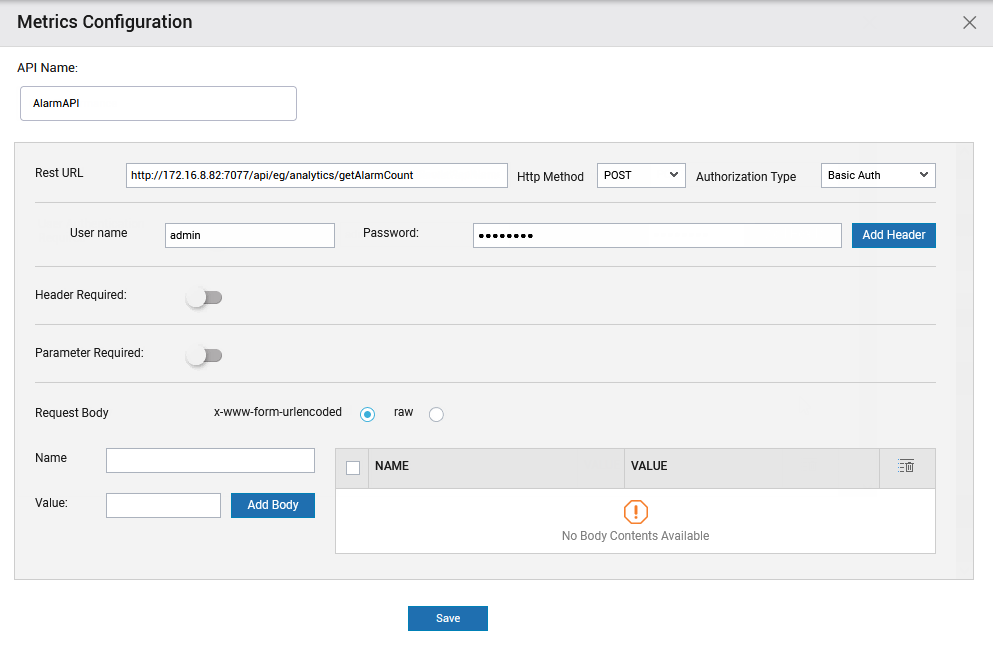
Figure 4 : Configuring the REST API with Basic Authentication
-
API Key - Pick this option if you wish to send a key-value pair to the REST API either in the request headers or query parameters. Once this option is chosen, specify the following:
-
Key - Specify the name of the key here.
-
Value - Specify the value corresponding to the Key.
-
Add API Key to - By default, Header is chosen from this list indicating that the key-value pair will be sent in the request headers. If you wish to send the key-value pair in the query parameters, then, pick the Param option from this list.
Clicking the Add button will add the key-value pair to the appropriate section (Header Required or Parameter Required) based on your selection from the Add API Key to list.
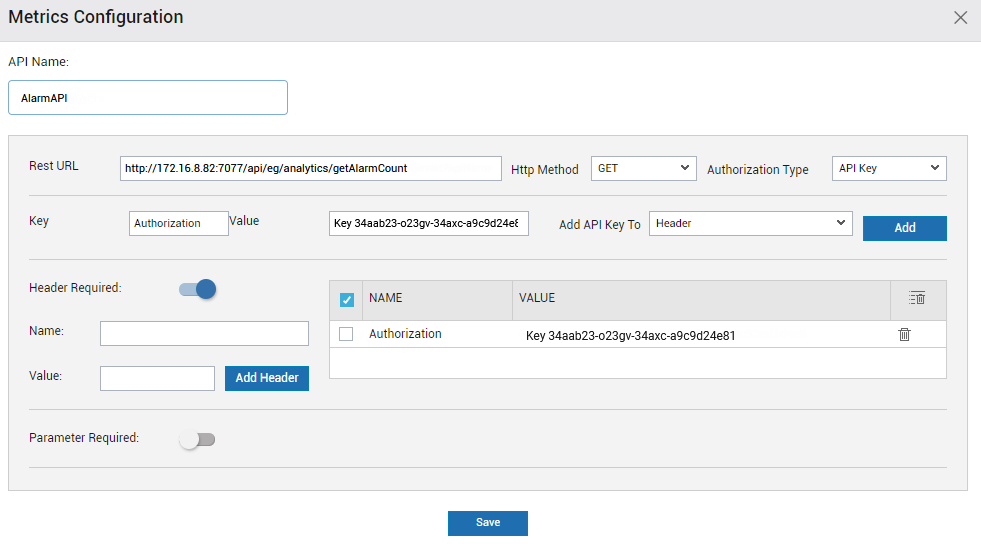
Figure 5 : Configuring the REST API with API Key
-
-
Bearer Token - Bearer tokens enable requests to authenticate using an access key, such as a JSON Web Token (JWT). The token is a text string, included in the request header. Against this text box, enter the API key value. For added security, store the API key in a variable and reference the variable by name. You can also specify the name of the variable here. Clicking the Add button will add the bearer token to the request header of the API and hence, the Header Required section will be auto-populated with the bearer token.
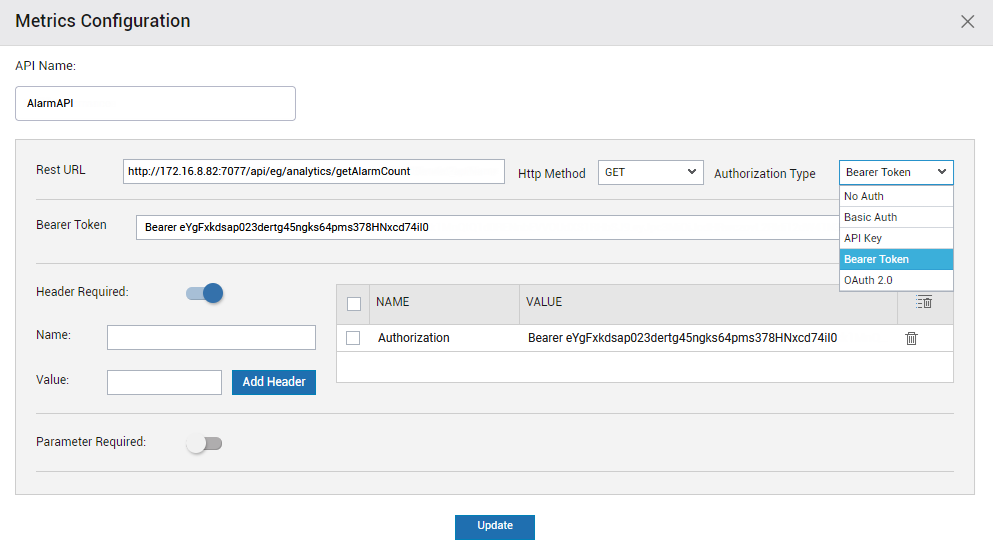
Figure 6 : Configuring the REST API with Bearer Token
-
OAuth 2.0 - Modern authentication or OAuth 2.0 enables client applications to access data provided by a third-party API. For example, as a user of a service, you can grant another application access to your data with that service without exposing confidential credentials such as username and password. With OAuth 2.0, you first retrieve an access token for the API, then use that token to authenticate future requests. Accessing data with OAuth 2.0 varies greatly between API service providers, but typically involves a few requests back and forth between client application, user, and API.
An example OAuth 2.0 flow is as follows:
-
A client application makes a request to the user to authorize access to their data.
-
If the user grants access, the application requests an access token from the service provider, passing the access grant from the user and authentication details to identify the client.
-
The service provider validates these details and returns an access token.
-
The client uses the access token to request the user data with the service provider.
If OAuth 2.0 is chosen, then, specify the following:
-
Grant Type - Pick an option from this list to instruct how the user is required to be authenticated with the service provider. By default, Password Credentials option is chosen from this list.
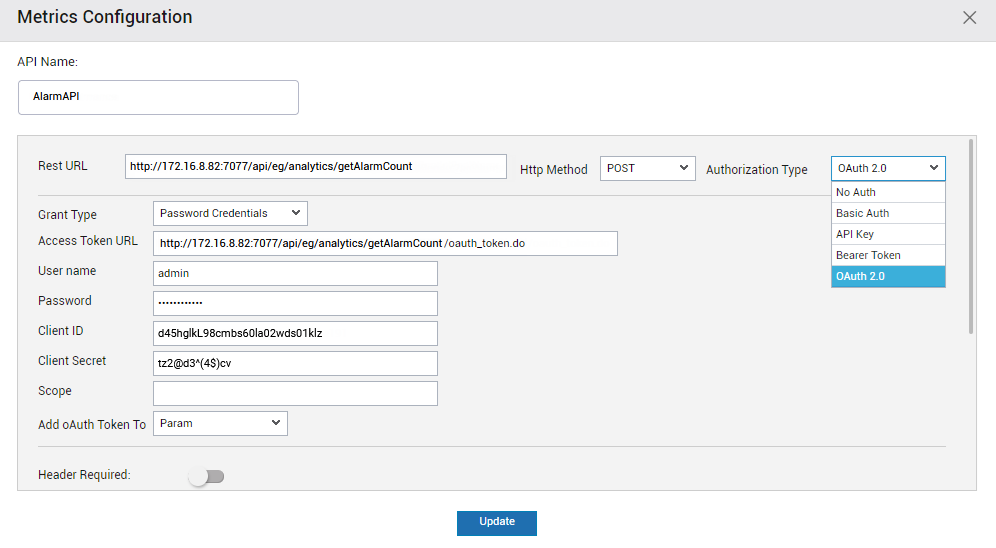
Figure 7 : Configuring the REST API with Password Credentials using OAuth2.0
If you have chosen Password Credentials option from the Grant Type list, then, specify the following:
-
Access Token URL - Here, specify the URL to access the authentication server of the service provider, to exchange an authorization code for an access token.
-
User name - Specify the user who is authorized to request the access token in exchange of an authorization code.
-
Password - Specify the password corresponding to the user specified in the User name.
-
Client ID - Here, specify the ID of the client application registered with the API provider.
-
Client Secret - Specify the secret key corresponding to the Client ID.
-
Scope - In this text box, specify the scope of access that you are requesting, which may include multiple space-separated values.
-
Add oAuth Token to - By default, Header is chosen from this list indicating that the oAuth token will be sent in the request headers. If you wish to send the oAuth token in the query parameters, then, pick the Param option from this list.
If you have chosen Client Credentials option from the Grant Type list, then, specify the following:
-
Access Token URL - Here, specify the URL to access the authentication server of the service provider, to exchange an authorization code for an access token.
-
Client ID - Here, specify the ID of the client application registered with the API provider.
-
Client Secret - Specify the secret key corresponding to the Client ID.
-
Scope - In this text box, specify the scope of access that you are requesting, which may include multiple space-separated values.
-
Add oAuth Token to - By default, Header is chosen from this list indicating that the oAuth token will be sent in the request headers. If you wish to send the oAuth token in the query parameters, then, pick the Param option from this list.
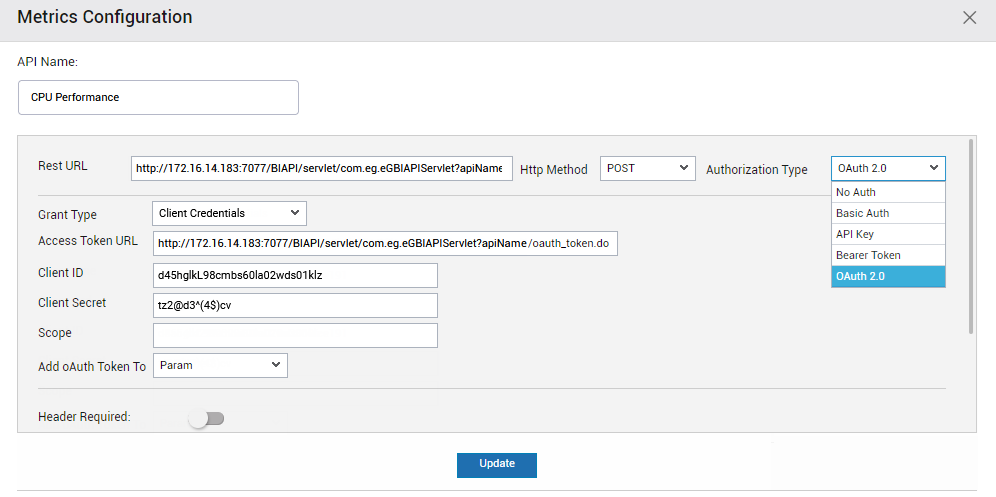
Figure 8 : Configuring the REST API with Client Credentials using OAuth2.0
-
-
-
-
Header Required - By default, the Header Required slider is turned off (see Figure 3) indicating that no additional information is provided in the HTTP header while executing the REST API. If you wish to provide additional information in the HTTP header, turn on the Header Required slider as shown in Figure 9. The Name and Value text boxes will then appear. Specify the Name and Value parameters that you need to include in the Header of the REST API and click the Add Header button. The NAME and VALUE columns in the section below will now be populated. To delete a Name and Value pair, click the
 icon available in that row. To delete all the Name and Value pairs, select the check box preceding the NAME column and click the
icon available in that row. To delete all the Name and Value pairs, select the check box preceding the NAME column and click the  icon.
icon.
-
Parameter Required - By default, the Parameter Required slider is turned off (see Figure 3) indicating that no additional parameters are specified as variable parts of your REST API resources i.e., the data that you are working on. If you wish to provide additional parameters, turn on the Parameter Required slider as shown in Figure 10. The Name and Value text boxes will then appear. Specify the Name and Value parameters that you need to include in the parameter of the REST API and click the Add Param button. The NAME and VALUE columns in the section below will now be populated. To delete a Name and Value pair, simply, click the
 icon available in that row. To delete all the Name and Value pairs, select the check box preceding the NAME column and click the
icon available in that row. To delete all the Name and Value pairs, select the check box preceding the NAME column and click the  icon.
icon.
-
Request Body - If POST is chosen from the HTTP Method list, then an additional Request Body section will appear as shown in Figure 3. By default, the x-www-form-urlencoded flag will be chosen indicating that the name and values are encoded in name-value tuples separated by '&', with a '=' between the name and the value. Specify the Name and Value parameters that you need to include in the body of the REST API and click the Add Body button. The NAME and VALUE columns in the section below will now be populated. To delete a Name and Value pair, simply click the
 icon available in a NAME, VALUE row. To delete all the Name and Value pairs, select the check box preceding the NAME column and click the
icon available in a NAME, VALUE row. To delete all the Name and Value pairs, select the check box preceding the NAME column and click the  icon. If you wish to post raw data, then you can choose the raw flag.
icon. If you wish to post raw data, then you can choose the raw flag. -
Clicking the Save button will invoke Figure 11.
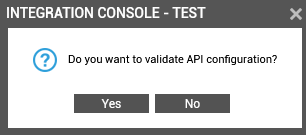
-
If you wish to validate your REST API configuration, then, choose the Yes button in Figure 11. If your validation is successful, then a message as shown in Figure 12 will appear.

-
If your REST API configuration validation failed, then , Figure 13 will appear.

-
Once your REST API is validated successfully, your configuration will be displayed in the API tab as shown in Figure 14.

Now, click the Measure tab in Figure 14 to configure the measures for the test. Figure 15 will then appear.

Clicking the Configure Metrics button in Figure 15 will invoke the Metrics Configuration pop up window as depicted by Figure 16.
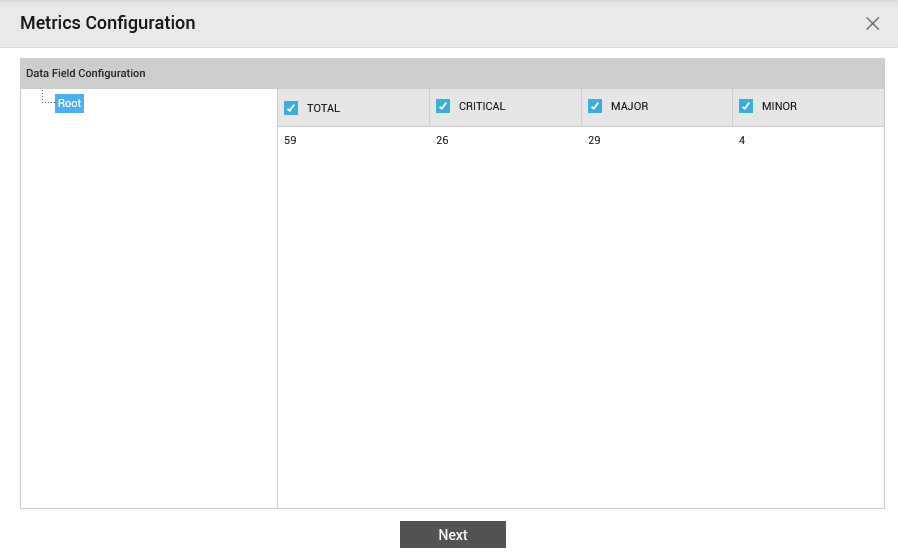
Figure 16 : The Metrics Configuration window with the API output
By default, the Data Field Configuration section in Figure 16 will list the data obtained as a result of the REST API execution in the target environment. Each set of data obtained will be listed in separate columns. By default, all the columns will be chosen indicating that each column label will be a measure of the test. If you wish to choose only a few columns, then, you can do so by deselecting the check box preceding the column name.
Note:
If the data returned upon execution of the REST API in the target environment is of JSON format and comprises of numeric values, then, the test is considered as a non-descritpor based test. If multiple rows of data are returned as the output of the executed REST API and if a column contains values that are alpha-numeric, then, you can consider the test to be a descriptor-based test. The Column that contains alpha-numeric values will be the "descriptor" of the test. If multiple columns with alpha-numeric values are returned as the output by the REST API, then, ensure that you select only one column from Figure 12.
Once you have chosen the measures, click the Next button in Figure 16. Figure 17 will then appear listing all the Measures chosen for the test.
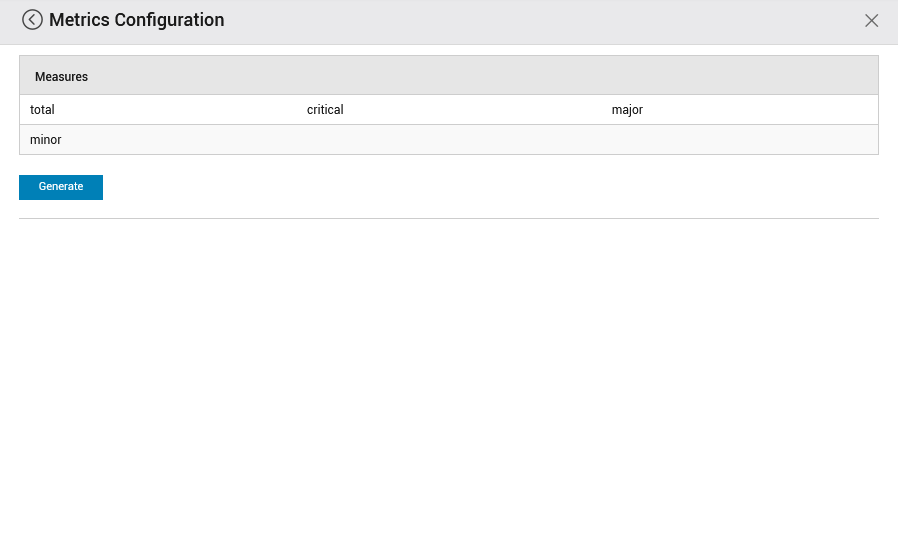
Figure 17 : Measures listed for the AlarmRESTAPI_ex test
Click the Generate button in Figure 17 to integrate the test’s implementation into the eG Enterprise system.
When a test’s measurements are successfully configured, the eG Enterprise system prompts the user to specify the default threshold settings for each of the measurements made by the newly added test as shown in Figure 18. You can set your own thresholds by clicking on the measure.
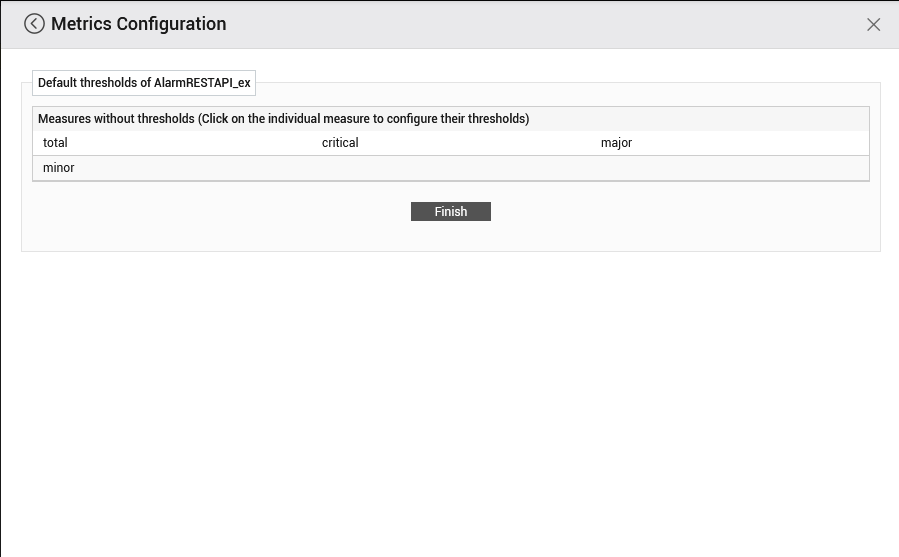
Figure 18 : Configuring thresholds for the newly created non-descriptor-based REST API test
Clicking the Finish button in Figure 18 will complete the creation of the non-descriptor based REST API test.